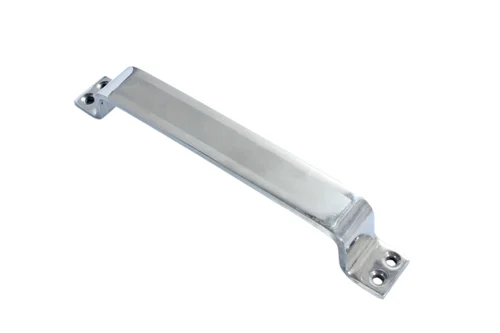Introduction
Overview of Steel Door Handle and Their Usages
Steel door handles are key hardware for homes and businesses. They are usually made from stainless steel or strong alloys. This makes them resistant to corrosion, wear, and impact. These features are great for busy areas. Their sleek design fits many architectural styles, from modern to classic.
Steel door handles are popular in homes and businesses because they are strong and versatile. In homes, you’ll find them on entry doors, interior doors, and cabinets. They offer reliable access and boost overall security. In commercial spaces, steel door handles are key for offices, retail stores, and public buildings. Their durability helps them handle frequent use.
Key Trends and Drivers Shaping the Steel Door Handle Market
- More focus on security in homes and businesses is boosting demand for strong steel door handles with advanced locks.
- Urban growth and new construction are increasing the need for durable and attractive door hardware, like steel handles.
- The shift towards minimalistic and modern design is making sleek, stainless steel handles popular in contemporary spaces.
- Greater awareness of hygiene is encouraging the use of antimicrobial coatings on steel door handles, especially in healthcare and food service areas.
- The rise of smart home technology is driving new door handle designs with electronic locks for added convenience and security.
- Sustainability concerns are pushing manufacturers to use eco-friendly methods and materials, leading to a rise in recycled steel door handles.
- E-commerce growth is giving consumers easy access to various steel door handles, allowing them to choose different styles and features.
- The demand for customizable hardware is prompting makers to offer various finishes and designs to suit personal tastes and architectural needs.
Key Points for Setting a Successful Steel Door Handle Manufacturing Plant
IMARC’s new report titled “Steel Door Handle Manufacturing Plant Project Report 2025: Industry Trends, Plant Setup, Machinery, Raw Materials, Investment Opportunities, Cost and Revenue, provides a complete roadmap for setting up a steel door handle manufacturing plant. The study covers all the requisite aspects that one needs to know while entering the steel door handle industry. This report is a must-read for entrepreneurs, investors, researchers, consultants, business strategists, and all those who have any kind of stake in the steel door handle industry.
Request for a Sample Report: https://www.imarcgroup.com/steel-door-handle-manufacturing-plant-project-report/requestsample
Market Analysis
The report provides insights into the landscape of the steel door handle industry at the global level. The report also provides a segment-wise and region-wise breakup of the global steel door handle industry. Additionally, it also provides the price analysis of feedstocks used in the manufacturing of steel door handle, along with the industry profit margins.
- Segment Breakdown
- Regional Insights
- Pricing Analysis
- Market Forecast
Product Manufacturing: Detailed Process Flow
- Raw Material Procurement
- Manufacturing Process
- Quality Inspection
- Packaging and Storage
Browse the Full Report with the Table of Contents: https://www.imarcgroup.com/steel-door-handle-manufacturing-plant-project-report
Project Requirements and Cost
Machinery and Equipment
- List of machinery needed for steel door handle production.
- Estimated costs and suppliers.
Raw Material Costs
- Types of materials required and sourcing strategies.
Utilities and Overheads
- Electricity, water, labor, and other operational expenses.
Project Economics
Capital Expenditure (CAPEX)
- Initial setup costs: machinery, land, and infrastructure.
Operating Expenditure (OPEX)
- Recurring costs: raw materials, labor, maintenance.
Revenue Projections
- Expected income based on production capacity and market demand.
Legal and Regulatory Compliance
- Licenses and permits required.
- Environmental compliance for biodegradable products.
- Industry standards for food-safe containers.
Hiring and Training
- Workforce requirements for plant operations.
- Training programs for quality production and safety.
Marketing and Distribution Strategies
1. Brand Positioning
-
- Establishing eco-friendliness as a USP.
- Establishing eco-friendliness as a USP.
- Sales Channels
- Online and offline distribution strategies.
- Online and offline distribution strategies.
- Collaborations
- Partnerships with foodservice chains, restaurants, and cafes.
- Partnerships with foodservice chains, restaurants, and cafes.
- Advertising
- Digital marketing, influencer promotions, and sustainability campaigns.
- Digital marketing, influencer promotions, and sustainability campaigns.
- Customer Retention
- Loyalty programs and corporate tie-ups.
- Loyalty programs and corporate tie-ups.
Browse Related Report:
Neem-Based Pesticide Manufacturing Plant
About Us:
IMARC Group is a global management consulting firm that helps the world’s most ambitious changemakers to create a lasting impact. The company excel in understanding its client’s business priorities and delivering tailored solutions that drive meaningful outcomes. We provide a comprehensive suite of market entry and expansion services. Our offerings include thorough market assessment, feasibility studies, company incorporation assistance, factory setup support, regulatory approvals and licensing navigation, branding, marketing and sales strategies, competitive landscape, and benchmarking analyses, pricing and cost research, and procurement research.
Contact Us:
IMARC Group
134 N 4th St. Brooklyn, NY 11249, USA
Email: sales@imarcgroup.com
Tel No:(D) +91 120 433 0800
United States: +1-631-791-1145

